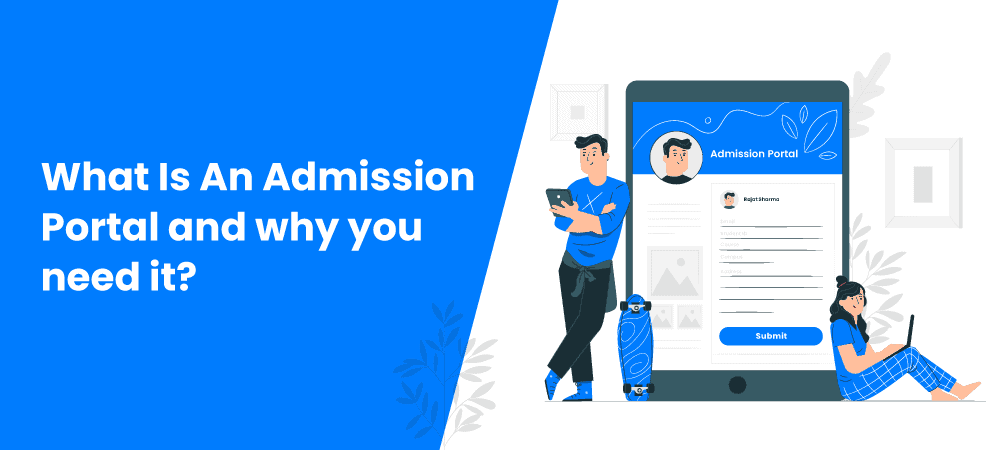
The majority of people go to a school or college to prepare for the future with a common belief that education shapes the future of a candidate by making them employable. Now, students might want to pursue education for a variety of reasons, but the institution needs to make its application process as easy as possible for its applicants because of the multiple choices available to them.
The most common vision of educational institutions is to make a demonstrable impact on the students’ lives and mold them for all future endeavors and responsibilities. Now, this is where an admission portal comes into the picture and makes the admission process as seamless as possible, ensuring a boost in the admission rates.
Why is an admission portal important?
As an organization providing educational services, what is the most important and challenging part? The most common answer – to increase the enrollment rate and be the most preferred organization for students. However, given the competition in the educational space, it is difficult to achieve, and that is where an admission portal comes into play.
An admission portal knits together a complete solution for end to end student lifecycle management. Be it running student recruitment ads or to get students and parents interested in downloading the application form. You can do this after several nudges from automated campaigns, and sometimes manual intervention from the admissions team.
How does an admission portal help?
The current pandemic has shown us that educational organizations need an online learning model along with a traditional one. The student recruitment process is generally long and requires several interventions from the counselors or admissions teams at different points in the student recruitment lifecycle. It is especially challenging to highlight their interests and provide complete transparency and knowledge. Aiding students in all their questions throughout the way would help recruit them into the university. The main questions are on scholarships, financial aids, courses offered, campuses, etc.
With people getting more habituated to the virtual space, they have started expecting most of their work to get completed online. Educational organizations have started adapting to this change as well. An admission portal lays the foundation brick for a student lifecycle management and has multiple reasons. Namely –
- To track online as well as offline channels like emails, phone calls, walk-ins, etc.
- Provision for parents to purchase the online application form using the admission portal.
- Automate the admission process by capturing leads from various channels, assigning them to your counselors, communicating with them via emails, and calling them up based on their activities.
- Reduce the manual efforts of Relationship Executives (Counsellors)
Education, as a whole, is seeing a shift towards an online or a hybrid model. New enrollment and alumni management are long-winding and disconnected. It requires a lot of paperwork and manual intervention and increases the chance of errors. This is where an admission portal comes into the picture.
Features of an admission portal
An admission portal accelerates the journey of a potential student until enrollment. It simplifies and streamlines the admission process, which is otherwise very long and consists of various stages.
The following are the stages involved in the student admission management.
Applicant registration
It starts with the registration of first-time applicants on the website form/portal. This is to capture the initial details, such as name, phone number, email ID, grade applied for, date of birth, and more. The process can further be automated to send a mail and OTP on the registered mobile number to verify if the details are genuine or not. Once it is verified, your counselors would know whether to get in touch with these applicants in case there has been no action after registering onto the portal.
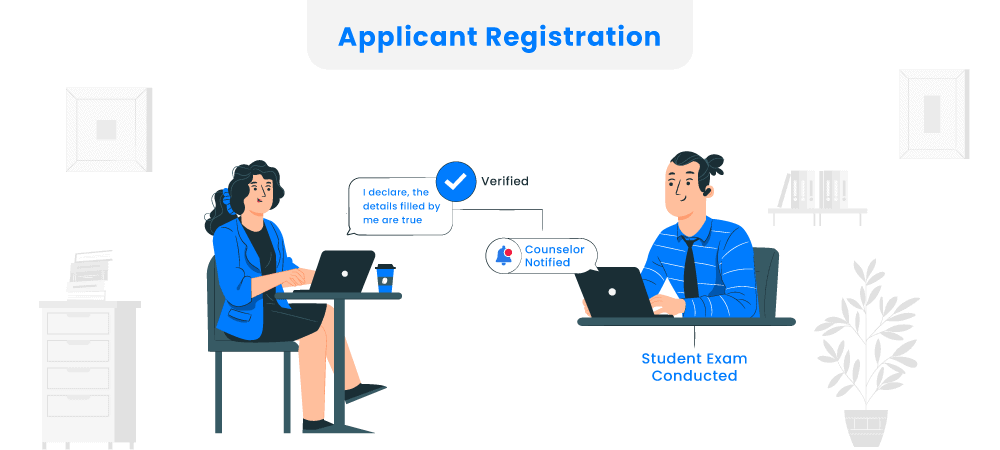
Inquiry and admission form
Post the applicant verification by the relationship executives, the next step includes inquiring for a registration form. This usually consists of student details, sibling details, and family details. Upon submitting the inquiry, it is sent to the counselors or relationship executives who would review and approve it once again. Parallelly, a dashboard for the applicant is created, and they can start the application process. The applicants can pay fees or download forms from the admission portal itself.
As soon as the applicant completes the fee payment, relevant emails and SMSs can be sent to them, confirming the payment details. Post payment, the applicant can fill out the student application form. It consists of student information, family details, emergency contacts, residential address, other details, such as second and third language selection, academic records, sibling details, previous academic records, and more. They can upload documents and signatures as well.
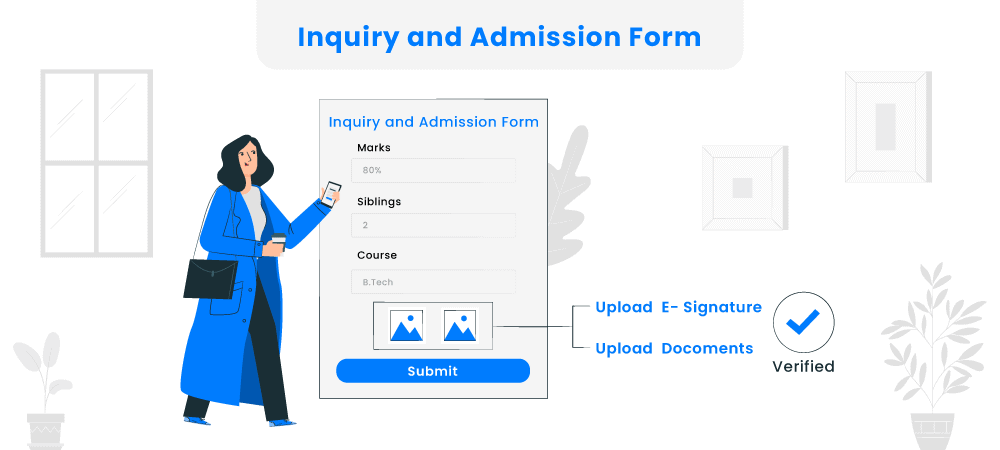
Declaration and assessment
Once the application is completed, You can include a declaration form in the end. The coordinators can contact the applicants who have paid the application fees and submitted the form. These coordinators are responsible for the assessment of the tests.
Based on the performance of the candidate, details are passed on to the principal/headmaster. The student information is updated in the system, and they are admitted to the institution.
Now, it may look like a simple process but can get very clumsy and difficult to manage when the number of applicants are more. An admission portal can automate the application process and streamline the workflow. It helps maintain transparency in the system so that all stakeholders have an idea of whatever is going on. It results in increased efficiency and productivity, which in turn can boost the admission rates.
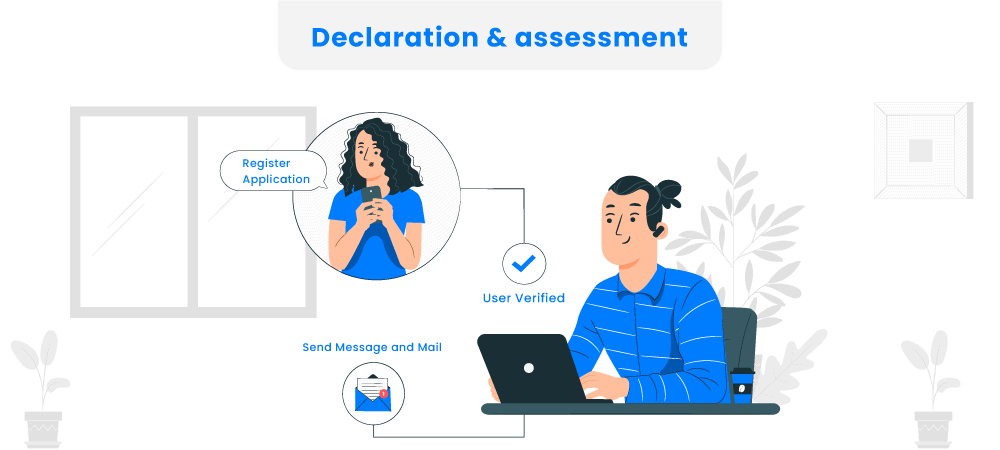
Benefits of using an admission portal
A good admission portal and higher enrollment rates are directly related. An admission portal helps educational institutions make the enrollment process seamless. At the same time, it also makes it easy for applicants to apply online. Your target audience needs to be content, and an applicant-friendly portal only adds to the advantage. The most common package is an integrated admission portal with a student information system. A comparison between a CRM and SIS would help you get started.
Here are a few benefits of using an integrated portal for admissions.
1. Increase your enrollment rates
Out of the countless number of educational institutions out there, Institutions need to find alternative ways to market themselves. The only way to stand out from the rest is to show students that you care about them. Let me explain.
An applicant starts his journey to fill out the registration form but could not complete it for some reason. The system tracks this in real-time. The admissions portal nudges the applicant to complete the application by sending out relevant emails and SMS and further notifying the admissions team to help him do the same, thereby increasing the application completion ratio.
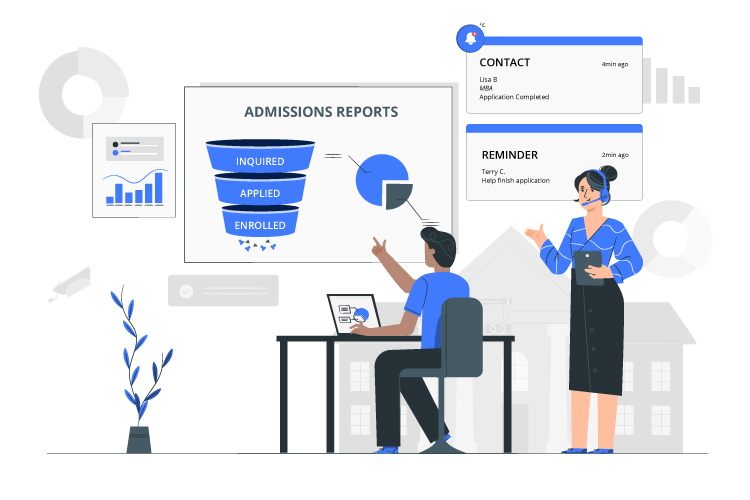
2. Map the complete student journey
Through an admission portal, you can sketch out the complete student journey. You can create your application forms on your website where students can sign up, pay their application fees, check their application status, and more – all in one place. Plus, you can customize the portals and application forms based on your website design to make it visually appealing and help student progress through the admission cycle.
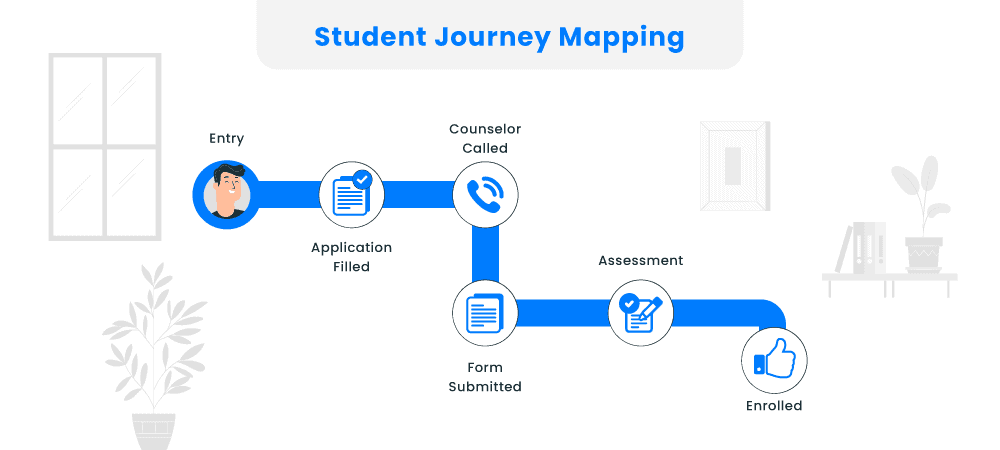
3. Enable multiple form submissions from applicants
To many students, the college brand name holds more value than a course. However, given the limited number of seats for a particular course, students should have a choice to apply to a different course as well.
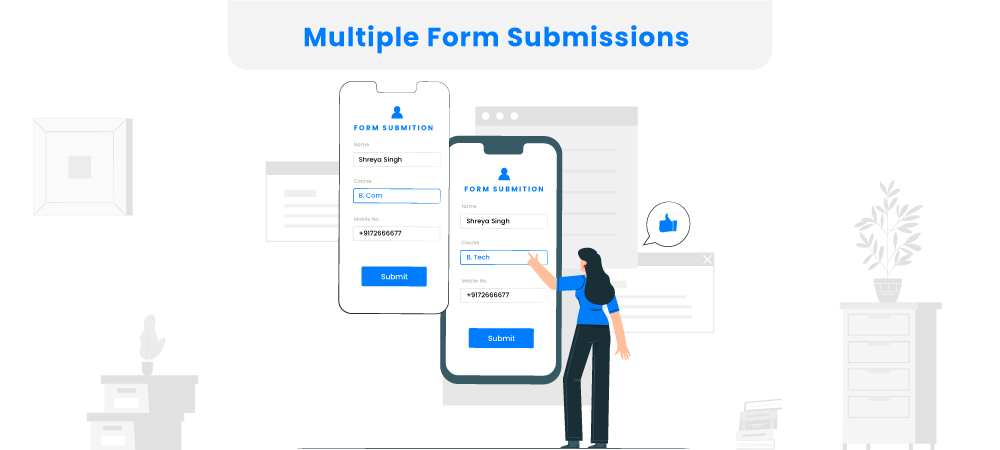
An admission portal eliminates the confusion and provides the students with the option of submitting multiple application forms. It helps the institution cater to every applicant’s preferences if their qualifications do not meet the institution’s cut-off.
4. Create a student-friendly interface
For a better experience, make your portal student-friendly. By this, we mean applicants would have a personalized dashboard, showing relevant information about their application status, the documents they have uploaded, their eligibility for different courses, their e-signatures, and more.
After enrollment, the portal holds details of the courses they are taking, notifications of financial payments due, class schedules, upcoming exams, credits obtained, forthcoming events, and other student-specific content.
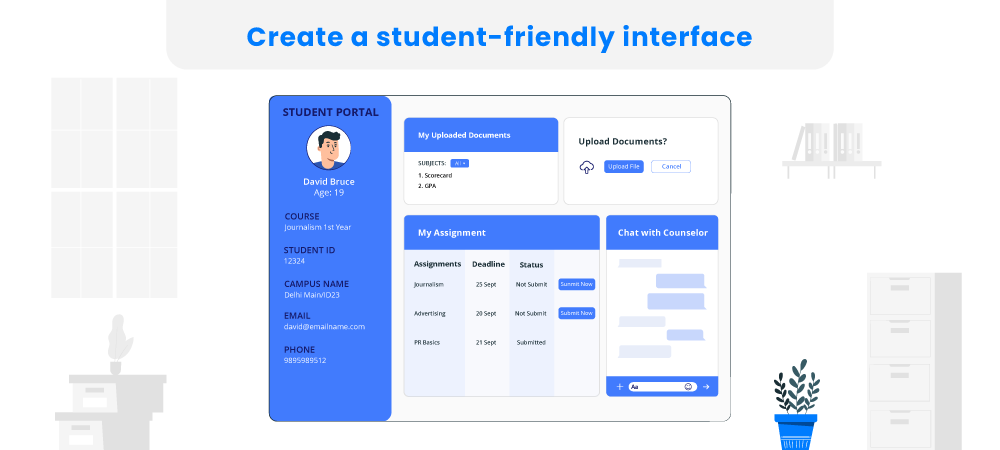
A smart admission portal helps your agents sense signals, and accordingly, they can send out relevant emails or SMS based on applicant requirements. It can be related to inquiry submissions, inquiry approval/rejections, application submissions, payment information, application status, admission status, and more.
For example, if an applicant is looking at financial aid options, your admissions team can initiate emails/texts and send them the right choices based on their percentages and more.
5. Enable online fee payment
The portal must also provide direct access to critical systems such as payment gateways, making it easier for students to pay the application fee. You should be able to integrate your payment modules in the admission portal securely. Execute the complete application process online, including admission fees collection or payment for other kinds of applications. A portal that consists of such sensitive information should have bank-level security.
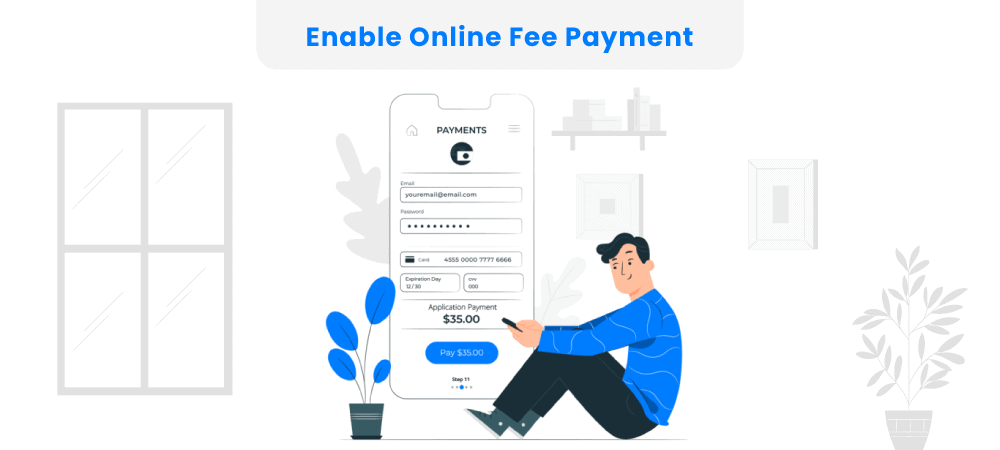
6. Self serve application forms.
Students like to do stuff themselves and would want to reach out only when faced with problems. This is where user-friendly, mobile-optimized applicant portals come into play. It ensures a smooth experience for the applicants.
If a student drops off in the middle and does not complete the application, they should be able to resume the application anytime. It will save their time. Also, in such instances, the portal system nudges the counselors to make a call or send a mail and remind them to complete the application.
It is also possible to add an option of chat/call within the portal. It can help provide instant support to the applicants while filling the admission form – reducing the drop off rates.
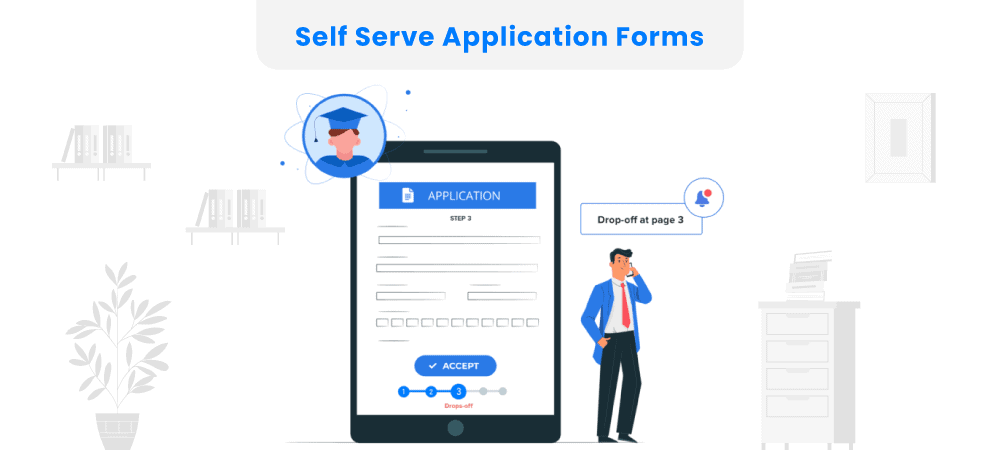
7. Auto-fill and auto-save applications
If a student applies for more than one course, they need not fill in the same information again for other courses. The auto-save and auto-fill features of the admission portal save time by populating the required fields with saved information. It saves time and, at the same time, makes it easy for students to enroll in multiple courses without much hassle.
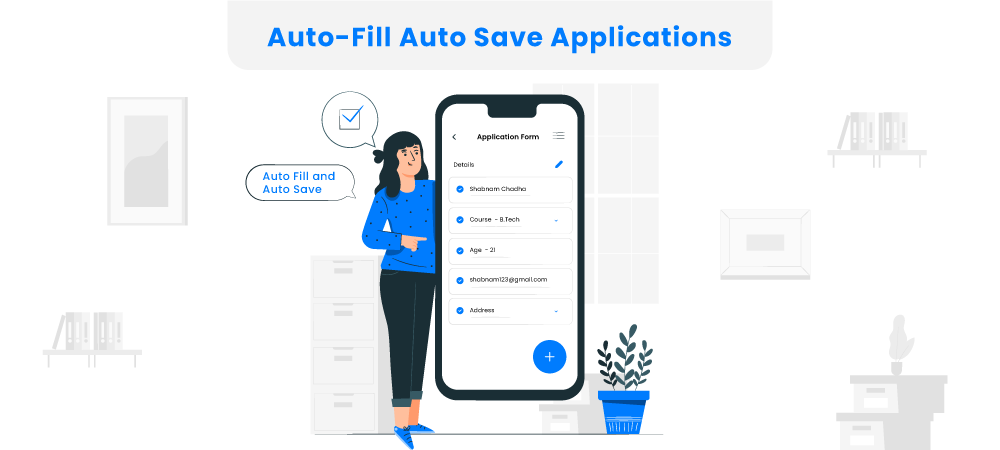
8. Supports all devices
The admission portal must be mobile-friendly because that’s how students engage much of the time – from their smartphones and tablets. So, uploading documents, signing applications, checking application status, and making payments should be possible anytime, anywhere.
Additionally, the portal should support chatbots through which students can quickly resolve their queries in real-time. For instance, if there is an issue regarding payment, applicants can get their answers immediately.
A new age admissions portal integrates these essential features as a single package. Additionally, a CRM and an admission portal go hand in hand to ensure a seamless applicant journey.
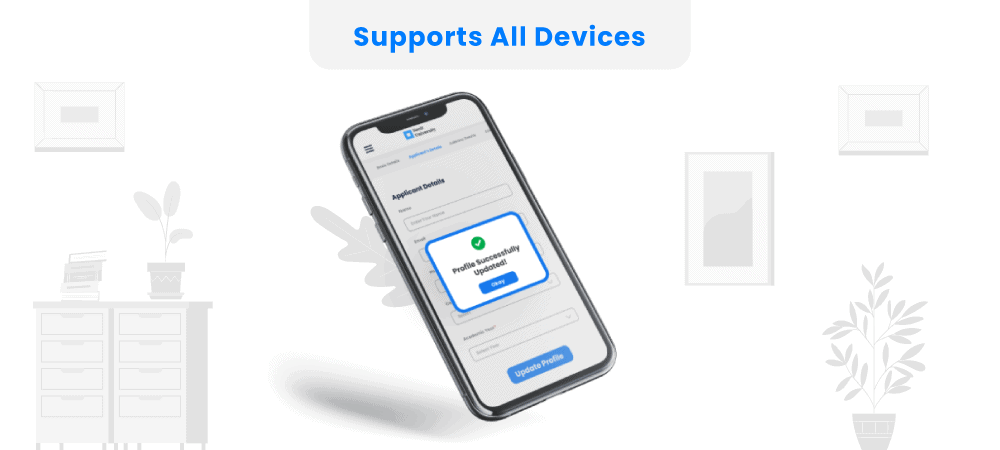
9. Enable application status tracking
What annoys applicants the most? Surprisingly it is not filling out lengthy application forms. Instead, it is not being able to track the status of their application.
Like a job seeker applying to various job openings, students would like to be informed about where they stand. They would like to know the following procedure, online interviews, screening examinations, approvals, etc.
An admission portal should display all relevant information to students so that they remain informed at each step of their journey.

Why should you integrate a CRM and an admission portal?
1. Capture student inquiries
A student inquiry can come from multiple sources like social media, phone calls, website visits, chatbots, etc. The first thing to do is capture the leads efficiently from various sources and ensure there is no lead leakage. When a student fills in the necessary details on the admission portal, the CRM captures it and notifies your admission team with all details.
A CRM ensures integrations with all lead generation channels such as phone, chat, ads, and email and notifies your admissions team to get in touch with these students as soon as possible.
2. Segment leads based on their course preferences and distribute them to relevant counselor
First, the CRM helps you segment leads in different buckets based on the courses/campus applied for. Then, the CRM software automatically distributes leads based on certain pre-defined logic. For instance, you can assign leads to relevant admission officers based on either the language spoken, campus interested in, zip code, city, the course of choice, or any other parameter.
The software helps you identify the most suitable applicants by checking their eligibility, such as age, GPA, interests, locations, and course applied. Accordingly, you can prioritize follow-ups with them.
3. Know your applicants’ intent
Each applicant has a different requirement. To understand their behavior and interest in your offering, you need to know them and track their actions and behavior.
A student behavior tracking will enable your admissions reps to have a context before conversing with the applicants. Student activity data can also help your marketing team run campaigns based on their interests and send relevant content to keep the students engaged. Based on their engagement, you can assign scores, and the lead with a higher engagement score is the one to be called first.
4. Personalize your communication
Keep in mind that all applicants are different and personalizing communication would increase the success ratio of educational organizations.
Personalization, however, is not so difficult. Because you have tracked and stored their activities such as course applied or brochure downloaded, you can send personalized messages or emails with these descriptions.
For example, you can send an email that says – Hey <Lead Name>,We noticed you downloaded a brochure for our <Program Name>, please let us know how we may help you further.
You can also create automated and personalized email sequences that trigger whenever you get a new inquiry.
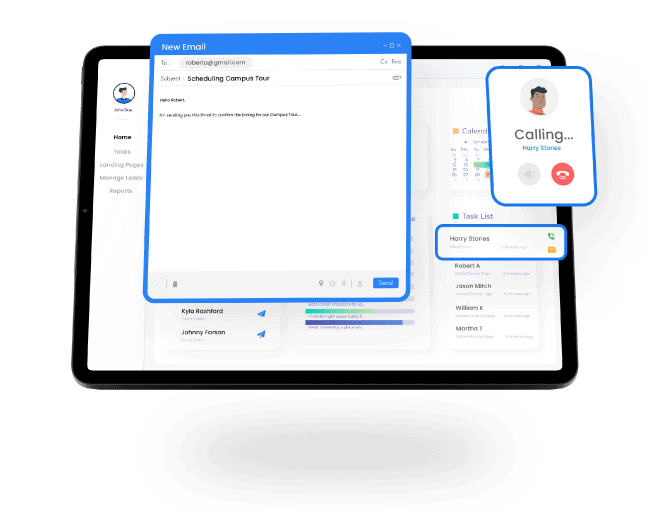
5. Integrate seamlessly with other apps
You might be using other tools to manage your admissions. For instance, marketing teams must be using Google Ads or Facebook Ads in their campaigns. Therefore, the portal and admissions CRM should integrate with other third-party tools to monitor campaigns, lead sources, and conversions.
6. Collect data and create custom reports
At the end of the day, you would like to see how your marketing campaigns are performing, which admission reps are closing more recruitments, what are the popular courses, at what time do you get the most inquiries, etc.
If admission reps spend a lot of time compiling data, they won’t be able to do their actual job, i.e., calling and engaging with students. That is why systems like CRM and admission portals are important as they help you collect and display information in desired formats – as and when required.
Based on the metrics you track, admission CRM also lets you create custom reports – displaying the information that matters to you. Managers and heads can get the reports emailed on a daily/weekly/monthly basis. This way, they’re always aware of the admission pipeline and can take necessary measures to fill the seats faster.
In conclusion
Education equips us with the knowledge and skills necessary to make it through life. But it is crucial for both – students and colleges that they match each other’s expectations. Else, it will hamper the course completion rates. Just like the “About us” section conveys the institution’s vision, an admission portal acts as a bridge that connects your vision with students.
Given the competition in the educational space, it is necessary to stand out from the rest. And, with the help of an admissions portal, the whole student onboarding journey becomes simplified. However, an admission portal without CRM is similar to a vehicle without gas.
It may seem like both the admission portal and CRM may have their separate tasks; however, when clubbed together, it acts as a very powerful tool in accelerating your admission rate.
Having said that, If you plan to increase your admission rate, do give LeadSquared’s Admission CRM a try! :)
FAQs
Prioritize data security. Choose an admission portal provider that prioritizes robust security measures. Look for features like data encryption, access controls, and regular security audits. Ensure compliance with relevant data privacy regulations to safeguard student information.
Develop a comprehensive change management plan. Provide staff with adequate training on the new admission portal functionalities. Offer clear and accessible user guides for students navigating the application process within the portal. Consider offering support channels for both staff and students during the initial implementation phase to ensure a smooth transition and maximize user adoption of the new system.
Costs can vary depending on factors like the portal’s features, scalability, and the chosen vendor. Some vendors offer tiered pricing based on functionality or number of users. Research different admission portal solutions and obtain quotes to determine the cost that aligns with your institution’s budget and needs.








